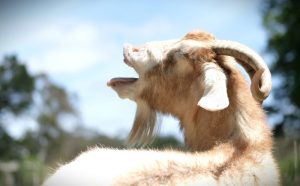
This year, as the din of the many zoo sounds was slowly dying down, the idea struck me that perhaps a deeper message underlies the seemingly comical aspect of imitating the various animal sounds. The Mishna teaches us in Pirkei Avos, “Be as bold as a leopard, as light as an eagle, as strong as a lion and as swift as a deer, to do the will of your Father in heaven.” This dictum of the sages was incorporated by the author of the Shulchan Aruch as his opening halacha. In its opening paragraph, the Shulchan Aruch exhorts us to marshal all our energies in the service of the Divine, from the very moment we arouse ourselves from sleep. Yet, why the analogy to animals? And how are we to harness the strength of a lion and the boldness of a leopard when serving our Creator? After all, compared to these mighty creatures, we are puny mortals, unequipped with the strength, swiftness or boldness that crowns these beasts. How is it possible to emulate them?
At the very beginning of Bereishis (Genesis), we read of the precision and order with which Hashem created the world. First, he created the setting for our world; light, day and night, as well as the planetary system. Subsequently, he created an environment in which all living things can exist. Only then was vegetation ready to sprout, followed by the creation of the animal kingdom. In the final flourish, man, the capstone of all creation, was formed as a unique hybrid of body and spirit.
The Midrash questions why Hashem waited until the end to make man, and answers that Hashem meant to thereby impart a profound lesson. Man’s physical being was not only formed from the dust of the earth, as the Torah tell us. Rather, the creation of man incorporated elements of all the things created before him. Similar to plants, human beings blossom and wither. We stand tall and can bear fruit as trees do. We possess some of the characteristics of animals; sometimes we may carry in our nature a recognizable strain of a particular animal.
Thus Jacob blesses his son Judah to best harness his kingly mission with his lion-like instincts; Naftali is compared to the fleet-footed deer; Don is likened to a snake and so forth. In another example of similarity to the animal world, built into the physical makeup of all human beings is a powerful animal-like instinct for self-preservation.
The question is, can we take these ‘animal’ instincts and make them subservient to our soul? Can we fulfill the purpose of our creation? If we do so, says the Midrash, then Hashem tells us, “You are the crown jewel of creation – you were formed last so that I could create a beautiful and perfect setting for your spirit. However, if your body follows its base cravings, then even a little beetle is superior to you, for it preceded you in the order of creation!”
This awareness that we do indeed have within us animal-like elements, such as lion-like strength and leopard-like boldness, should lead to an obvious conclusion. One’s body can act with alacrity and determination in swift pursuit of its needs; we can be light-footed as deer in pursuit of self-gratification. On the other hand, it these very character traits that pose the greatest challenge: will we harness them properly to nurture not only our bodies but our souls? Will we consecrate these instincts to perform the Divine will?
The ultimate test of whether we are on the right path is whether, at the moment of awakening each morning, we consciously rededicate all our complex, powerful physical energies to the service of the Almighty.
With this elevating thought, we join in the high-spirited ritual of imitating each animal in the rendition of Chad Gadya, following the resounding chorus that leads us to the ultimate destination, Hakadosh Baruch Hu, Himself.
Wishing you a wonderful Shabbos
Rabbi Naftali Reich
Text Copyright © 2013 by Rabbi Naftali Reich and Torah.org.
Rabbi Reich is on the faculty of the Ohr Somayach Tanenbaum Education Center.


